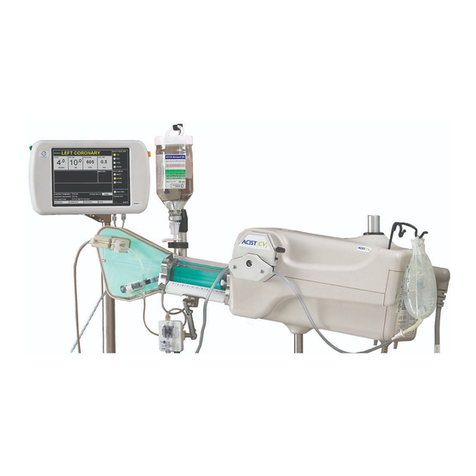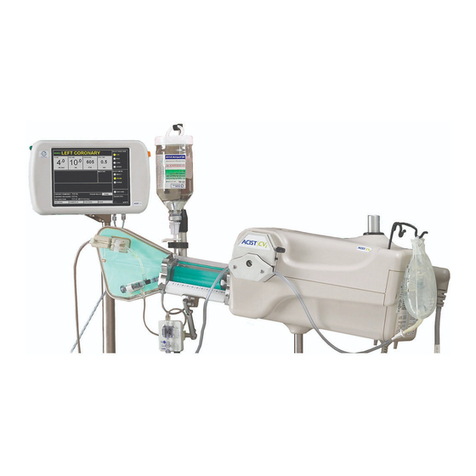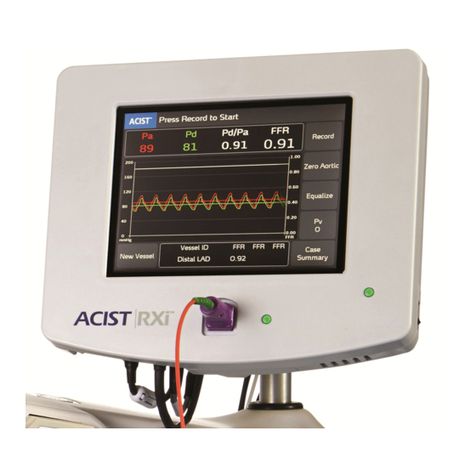
ACIST | CVi® System User's Guide 901418-003,01 2019-08 English (USA) | 3
Contents
1 Introduction
Intended Use ..................................5
Contraindications ..............................5
Requirements for Use ..........................5
Aseptic Technique..............................6
About This User’s Guide ........................6
Manual Conventions ...........................7
2 Warnings, Cautions, and Symbol Denitions
Warnings ......................................9
Aseptic Technique ..........................9
Air Embolism ...............................9
Air in the Monitoring Line ...................9
Air Column Detect Mechanism ..............9
Disconnect Before Flushing Air .............10
Use of Patient Kits..........................10
Cables .....................................10
Catheters ..................................10
Cleaning...................................10
Closed Stopcock ...........................11
DEHP (Phthalate)...........................11
Electrical Isolation..........................11
Emergency Shutdown .....................11
Flammable Gases ..........................11
High Flow Rate Injections ..................11
Injection System Setting ...................11
Mounting System ..........................11
Residual Contrast ..........................11
Shock Hazard . . . . . . . . . . . . . . . . . . . . . . . . . . . . . .11
System Messages ..........................12
Safe Use of Equipment .....................12
Cautions ......................................13
Accessories ................................13
Bed Rail Mount ............................13
Cleaning...................................13
Control Panel Touch Screen ................13
Electromagnetic/Electrostatic Guidance ....13
Excessive Injections . . . . . . . . . . . . . . . . . . . . . . . .14
Eye Protection .............................14
Injection System Temperature ..............14
Leakage Current ...........................14
Line Power.................................14
Lock Button................................14
Locking Wheels . . . . . . . . . . . . . . . . . . . . . . . . . . . .14
Mixing Hardware Components .............14
Mounted System...........................14
Pressure Transducer........................14
Preventive Maintenance....................15
Removing the Contrast Spike...............15
Rx Only ....................................15
Saline Pump ...............................15
Training ...................................15
X-Ray Cable................................15
Symbol Denitions ............................16
3 System Description
Introduction ..................................19
System Hardware .............................20
Power Supply ..............................21
Injector Head ..............................22
Mounting..................................22
Audible Indicators.............................24
Touchscreen Functions and
Sample Injection Images ......................24
Flow.......................................24
Volume ....................................24
Pressure ...................................24
Rise Time ..................................25
Select Injection ............................25
Patient Kits....................................28
Select Mode ...............................28
End Case...................................28
System Messages Area .....................28
BT2000 Manifold Kit........................29
AT P54 and AT P65 AngioTouch Kits.........29
A2000 Syringe Kit ..........................30
4 Setup
Setup Overview ...............................32
Power On .....................................32
Prepare the Contrast Container ................33
Load the Syringe Assembly ....................34
Load Contrast .................................34
Load Saline Tubing Assembly ..................37
Purge the Tubing..............................39
AngioTouch
Hand Controller Setup.........................40
Connect the Patient Catheter ..................41
Zero the Pressure Transducer ..................41
5 Perform an Injection
Adjust Parameters Based on
Physician Preference ..........................43
Arm the Injector...............................44
Inject Contrast ................................44
Large Injections............................44
Disarm the Injector.........................44
Automatic and Manual Rells...............44
Perform Contrast Purge .......................45
Perform Saline Flush using
0.9% Normal Saline............................45
X-Ray Sync (Optional) ......................45
Flush Saline Using the Hand Controller .....45
Standby ......................................46






























